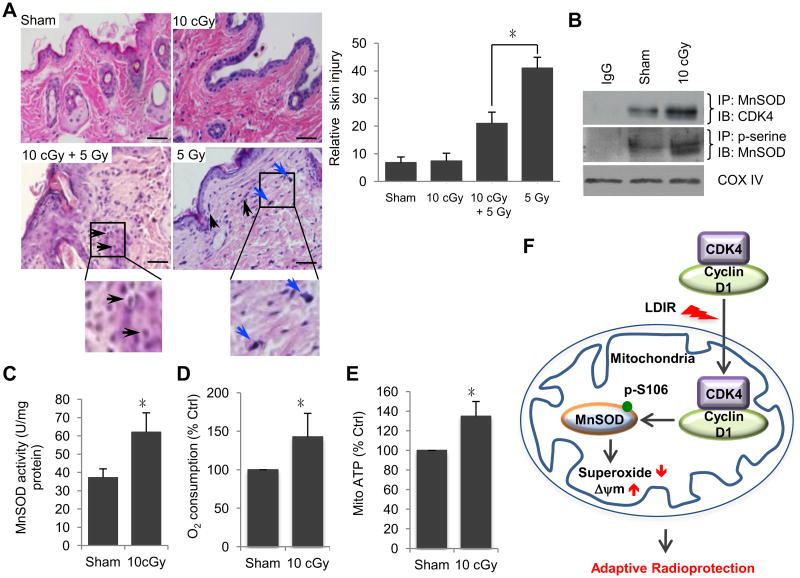Fig. 7.
Cyclin D1/CDK4/MnSOD pathway in LDIR-induced adaptive protection in vivo. Female BALB/c mice were exposed to whole body irradiation with different dose combination (sham, 10 cGy, 5 Gy or 10cGy+5Gy) or single low dose (10 cGy). Mice were then dissected at the desired time point after irradiation and tissues were used for immunohistochemistry assay or preparation of mitochondria fractions. Mean ± S.E.M.; *P < 0.05; n ≥ 3. (A) Representative histological changes and quantitative results of inflammatory cells in skin epidermal tissues from mice received indicated dose combination of whole body irradiation. Mice were exposed to 10 cGy, 10 cGy + 5 Gy or 5 Gy irradiation and dissected at the desired time points after radiation. Mouse skin tissues were embedded and sliced. The tissue sections were subjected to HE staining and the images were presented to show the skin injury by irradiation. Black arrow, lymphocyte infiltration. Blue arrow (5 Gy), abundant fibroblast proliferation. Sham, no radiation control. Scale bar, 50 μm. (B) Enhanced CDK4 interaction with MnSOD and increased MnSOD phosphorylation in mitochondria of skin epidermal layers from 10 cGy-irradiated mice. (C) MnSOD activity measured in skin epidermal tissues from mice treated with 10 cGy irradiation. (D) Enhanced mitochondria oxygen consumption in livers from 10 cGy irradiated mice. (E) Enhanced mitochondria ATP production in livers from 10 cGy irradiated mice. (F) Schematic show of CDK4/MnSOD signaling pathway in LDIR-induced cellular adaptive protection. LDIR induces Cyclin D1/CDK4 mitochondria relocation and phosphorylation of MnSOD at serine-106, causing an enhanced mitochondrial homeostasis via MnSOD activation and oxidative respiration.

